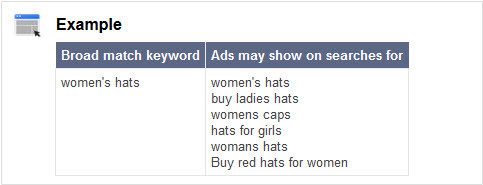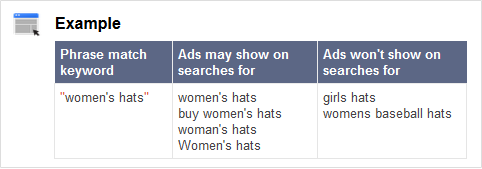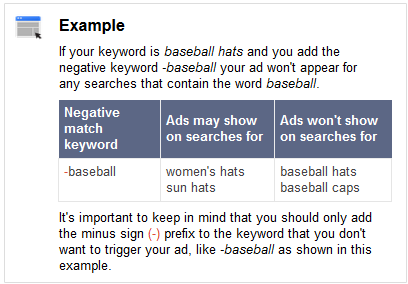You can use match types with your keywords to help control which searches can trigger your ad. Ranging from broad to narrow, here are the different match types: broad match, broad match modifier, phrase match, exact match, and negative match.
In general, the broader the keyword matching option, the more traffic potential that keyword has; while the narrower the keyword matching option, the more relevant that keyword will be to someone’s search. Understanding these differences can steer you in choosing the right keyword matching options and can help you improve your return on investment (ROI).
Broad Match
The default matching option, broad match means that your ad may show if a search term contains your keyword terms in any order, and possibly along with other terms. Your ads can also show for close variations of your keywords.
Sticking with the broad match default is a great choice if you don’t want to spend a lot of time building your keyword lists and want to capture the highest possible volume of ad traffic.
Broad Match Modifier
You can add a modifier, a plus sign (+), to any of the terms that are part of your broad match keyword phrase. By adding a modifier, your ads can only show when someone’s search contains those modified terms, or close variations of the modified terms, in any order.
Unlike broad match keywords, modified broad match keywords won’t show your ad for synonyms or related searches. For this reason, it adds an additional level of control. Using broad match modifier is a good choice if you want to increase relevancy even if it means you might get less ad traffic than broad match.
Phrase Match
With phrase match, your ad can show when someone searches for your exact keyword, or your exact keyword with additional words before or after it. We’ll also show your ad when someone searches for close variations of that exact keyword, or with additional words before or after it.
Using phrase match can help you reach more customers, while still giving you more precise targeting. In other words, your keywords are less likely to show ads to customers searching for terms that aren’t related to your product or service.
To use a phrase match keyword, simply surround the entire keyword with quotation marks. For example, “women’s hats”.
Exact Match
With exact match, your ads can appear when someone searches for your exact keyword, without any other terms in the search. We’ll also show your ad when someone searches for close variations of that specific keyword.
Unlike phrase match, if someone searches for additional words before or after your exact keyword, your ad won’t show. Using exact match means that your keywords are targeted more precisely than broad match or phrase match.
To use an exact match keyword, simply surround the entire keyword with brackets. For example, [women’s hats].
Negative Match
You can use negative match prevent your ad from showing to people searching for certain terms. Your ad won’t show if a search term contains the keyword term you define with a minus sign (-) prefix. Negative keywords are an especially useful way to filter out irrelevant traffic and thus prevent unwanted clicks.
As shown in the screenshot below, negative keywords have their own section (which is minimized by default) below your keyword table. When you create a negative keyword (or make one from an existing keyword by adding the negative symbol), it will show up there. Note that you can use negative keywords in conjunction with other match types. For example, you could use an exact match negative keyword to prevent your ad from showing to people who searched for that exact keyword.




